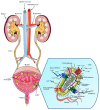Urinary Tract Infections Caused by Uropathogenic Escherichia coli: Mechanisms of Infection and Treatment Options
- PMID: 37445714
- PMCID: PMC10341809
- DOI: 10.3390/ijms241310537
Urinary Tract Infections Caused by Uropathogenic Escherichia coli: Mechanisms of Infection and Treatment Options
Abstract
Urinary tract infections (UTIs) are common bacterial infections that represent a severe public health problem. They are often caused by Escherichia coli (E. coli), Klebsiella pneumoniae (K. pneumonia), Proteus mirabilis (P. mirabilis), Enterococcus faecalis (E. faecalis), and Staphylococcus saprophyticus (S. saprophyticus). Among these, uropathogenic E. coli (UPEC) are the most common causative agent in both uncomplicated and complicated UTIs. The adaptive evolution of UPEC has been observed in several ways, including changes in colonization, attachment, invasion, and intracellular replication to invade the urothelium and survive intracellularly. While antibiotic therapy has historically been very successful in controlling UTIs, high recurrence rates and increasing antimicrobial resistance among uropathogens threaten to greatly reduce the efficacy of these treatments. Furthermore, the gradual global emergence of multidrug-resistant UPEC has highlighted the need to further explore its pathogenesis and seek alternative therapeutic and preventative strategies. Therefore, a thorough understanding of the clinical status and pathogenesis of UTIs and the advantages and disadvantages of antibiotics as a conventional treatment option could spark a surge in the search for alternative treatment options, especially vaccines and medicinal plants. Such options targeting multiple pathogenic mechanisms of UPEC are expected to be a focus of UTI management in the future to help combat antibiotic resistance.
Keywords: alternative treatment options; urinary tract infections; uropathogenic Escherichia coli.
Conflict of interest statement
The authors declare no conflict of interest.
Figures







References
Publication types
MeSH terms
Substances
Grants and funding
LinkOut - more resources
Full Text Sources
Other Literature Sources
Medical

